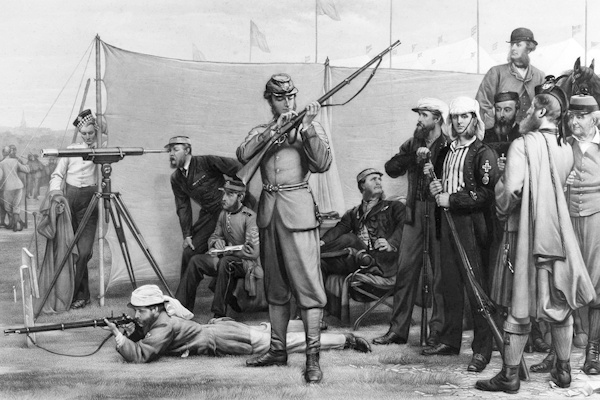You are here: Home > Marksmanship > 19th Century Riflemen > England > Sir Henry Halford
Source: Dictionary of National Biography, 1901 supplement
The Dictionary of National Biography Founded in 1882 by George Smith. London, England
Halford, SIR HENRY ST. JOHN, THIRD BARONET (1828–1897), rifleman, born on 9 Aug. 1828, was the son of Sir Henry Halford, second baronet (1797–1868), M.P. for South Leicestershire from 1832 to 1857, by his wife Barbara, daughter of his uncle, Sir John Vaughan (1769–1839), by his wife and first cousin, Augusta St. John. Sir Henry Halford, first baronet, the physician, was his grandfather. Henry St. John Halford was at Eton from 1840 to 1845. He matriculated as a commoner of Merton College, Oxford, on 26 Nov. 1846, and graduated B.A. in 1849. At his father’s death on 22 May 1868 he succeeded to the baronetcy. Thenceforth he chiefly resided at the family residence, Wistow Hall, Leicestershire.
Halford took an active part in the public business of his county, Leicestershire. In 1872 he held the office of high sheriff. In June 1876 he was elected deputy chairman of quarter sessions, and at midsummer 1883 chairman. This office he held till his death. On the formation of the Leicestershire county council in 1889 he was elected chairman, and held the office till 1893, when ill health compelled him to resign.
It was, however, in connection with rifle shooting and the volunteer movement that Sir Henry was best known. At the beginning of the movement in 1860 he took command of a company of the Leicestershire volunteers. In 1862 he became colonel of the battalion. In 1868 he resigned, but resumed the office in 1878, and held it till 1891, in which year he became honorary colonel. In 1886 he received the order of C.B.
In the first rifle match between England and Scotland for the Elcho shield in 1862, Sir Henry shot for England, and made the highest score. He subsequently shot in 1863, 1865, 1871, 1872, 1874, 1877–84, 1886–1890, and 1893. In 1872, when England won, he again made the highest score. His principal individual successes at the National Rifle Association meetings at Wimbledon and Bisley were the Albert prize in 1862 and 1893, the Duke of Cambridge prize and the Association cup in 1871, and the Dudley in 1893, besides a vast number of less important prizes. He also in 1864 won the Cambridge long-range cup, a match of great importance, with the newly invented Metford rifle.
In 1877 Sir Henry acted as captain of a team of eight riflemen chosen from England, Ireland, and Scotland, who went to the United States to shoot a match at long distances against eight representative American marksmen. The latter won. In 1882 Sir Henry, this time with two colleagues, took out a team of British volunteers to shoot a match, twelve on each side, against the National Guard of America with service rifles. The British won, and repeated their success in a similar match shot in 1883 at Wimbledon. On that occasion Lord Brownlow, then chairman of the National Rifle Association, was the titular captain of the British team, with Halford as his working subordinate.
In 1880 Halford was appointed a member of the government small arms committee. The introduction of the Lee-Metford rifle as the British service arm was due to the report of that committee. Halford had great knowledge, both theoretical and practical, of gunnery and gunmaking; he was intimate with William Ellis Metford, the inventor of the Lee-Metford rifle, and constantly co-operated with him in his experiments. In 1888 Halford published ‘The Art of Shooting with the Rifle.’
Halford died on 4 Jan. 1897. In 1853 he married Elizabeth Ursula, daughter of John Bagshawe, but left no issue. His brother John succeeded him, and the baronetcy became extinct at his brother’s death.
John Andrew Doyle
